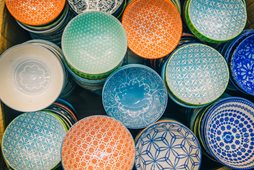
Porcelain, along with paper and silk, is one of Asia’s most significant contributions to civilization. Developed in China around 200 BCE, fine porcelain’s impermeability and ability to withstand hot temperatures made it valuable in its plainest form, but the smooth white surfaces soon became the ideal blank canvas for an enduring tradition of fine painting and decoration using colorful glazes and detailed drawings.
Though Japan had long admired its regional rival’s facility and dexterity with fine porcelain, it was not until the sixteenth century that captured Korean potters were able to teach Japanese artisans the intricate secrets of fine Chinese porcelain. The Japanese learned quickly and incorporated exquisitely painted porcelain into their time-honored tea ceremony. Employing the technique of Chinese overglaze enameling, the Japanese artists produced Imari ware, which soon became a popular export to Western Europe.
Near modern-day Kanazawa, Kutani ware developed in the latter half of the seventeenth century after white porcelain stone was discovered near a neighboring gold mine. A kiln was established, and the porcelain soon became renowned throughout Japan. The signature designs, today is known as “Ko-Kutani” or “old Kutani” are immediately recognizable by their vibrant colors: deep green, yellow, dark blue and purple in the Aote style and red, green, purple, dark blue, and yellow of the Iroe school. This initial stage of the Kutani kilns was short-lived, lasting only 53 years before the kilns were abandoned. Just why still puzzles art historians, who have pored over shards of the seventeenth-century pottery excavated in the 1970s. It seems likely that political machinations affected the viability of the Kutani kilns and lack of funds forced the closures.
But the Kutani tradition endured, and was brought back to life in the early nineteenth century by an idealistic businessman who focused less on running a profitable business than on matching the flawless quality of the Ko-Kutani era, producing excellent versions of the deep-glazed porcelain, which are known as “Revived Kutani.” Under his leadership, the Kutani works floundered once again and in 1831, the factory closed.
Under more entrepreneurial management, the works came back to life during the late nineteenth century. Potters during this era achieved considerable status as individual artisans rather than as a collective kiln, and the distinctive Kutani designs with its deep glaze, signature bold colors, and fine-line drawings reclaimed much of their earlier popularity not only in Japan but throughout the world. After four hundred years of fits and starts, the Kutani works are finally on a firm footing!
Learn more about Japan’s long history of ceramic design on a visit to the Kutani Kosen Pottery Studio, part of Alexander + Robert’s popular itinerary,
From Japan’s Inland Sea to the Alps, which also includes visits to 4 additional UNESCO World Heritage sites. Always capped at 16 guests to ensure the highest level of service and quality.